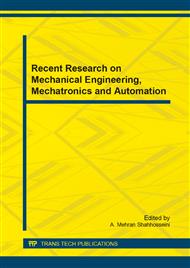[1]
Z.A. Tang, L.D. Wang, On Microscale Theory, Optics and Precision Engineering. 9 (6) (2001): 493-498.
Google Scholar
[2]
Bhushan, B, Nanotribology and Nanomechanics: An Introduction. Hei-delberg: SpringerVerlag, (2005).
Google Scholar
[3]
International Organization for Standards. Metallic Materials-Instrumented Indentation Test for Hardness and Materials Parameters. ISO 14577, Geneva, Switzerland, (2002).
Google Scholar
[4]
J. Yan, H. Zhao, T. Kuriyagawa, et al. Nanoindentation and diamond turning tests on compound semiconductor InP. Proceedings of the 6th euspen International Conference, (2006) 276-279.
Google Scholar
[5]
G.Q. Shi J.Y. Yu,Y. X . Cai J.W. Yan, Diamond Turning of Single Crystal Germanium and Silicon.J. ChangChun Inst. Opt. &Fine Mech. 19(1) (1996): 6-10.
Google Scholar
[6]
X.J. Yang, H.W. Kang, C.M. Yang, Finite Element Analysis And Simulation of the Micro/Nano-Scale Contact Mechanics Behavior. Journal of Mechanical Strength. 35(5)(2013): 103-108.
Google Scholar
[7]
Y. Liu, D.F. Chen, Measurement of Material Mechanical Properties Using Nanoindentation and Finite Element Simulation. Journal of Wuhan University of Technology. 27(4)(2003): 690-693.
Google Scholar
[8]
Y.Z. Guo, Fem Simulation of Micro-nano Indentation and Research on Calculation of Indentation Hardness. Harbin Institute of Technology. 2011. 6 pp.8-9.
Google Scholar
[9]
W. C Oliver, G.M. Pharr. Improved technique for determining hardness and elastic modulus using load and displacement sensing indentation experiments, Journal of Materials Research, 7(6)( 1992): 1564-1580.
DOI: 10.1557/jmr.1992.1564
Google Scholar
[10]
D. Beegan, S. Chowdhury, M.T. Laugier. Work of indentation methods for determining copper film hardness. Surface and Coating Technology, 192 (2005): 57-63.
DOI: 10.1016/j.surfcoat.2004.02.003
Google Scholar
[11]
A. Bolshakov, W.C. Oliver, G.M. Pharr, Influences of stress on the measurement of mechanical properties using nano indentation: Part II: Finite element simulations MaterRes, 1l (3) (1996) : 760-768.
DOI: 10.1557/jmr.1996.0092
Google Scholar
[12]
Z.J. Wang. The Research on Technology of Six Prism Drum Germanium Single Crystal By Ultra-Precision Turning. Changchun University of Science and Technology. 2012. 3 pp.11-12.
Google Scholar
[13]
C.J. Tao, Z.Q. Wang, S.H. Chen, The Influence of Indenter Tip Radius to Micro-Indentation Test . Applied Mechanics and Materials, 36(6)( 2004): 680-687.
Google Scholar
[14]
X.Y. Niu, J. Lin, X.F. Shu, Experiment and Finite Element Simulation on the Experimental Determination of Mechanical Properties of Zeolite Sodalite Crystals by Nanoindentation Technology. Journal of Taiyuan University OF Technology, 36(2)( 2005): 119-122.
Google Scholar
[15]
T.L. Zhang, Y.H. Chen, W.H. Huang,X. Wang. Analysis of tip effects in nanoindentation , Journal of University of Science and Technology of China, 39(4) (2009): 403-408.
Google Scholar
[16]
Z.G. Yao, X.F. Zhu, G.P. Zhang, Comparison of indentation-induced deformation and fracture of several kinds of semiconductor single crystals [J]. Chinese Journal of Materials Research, 23(2)(2009): 180-186.
Google Scholar


